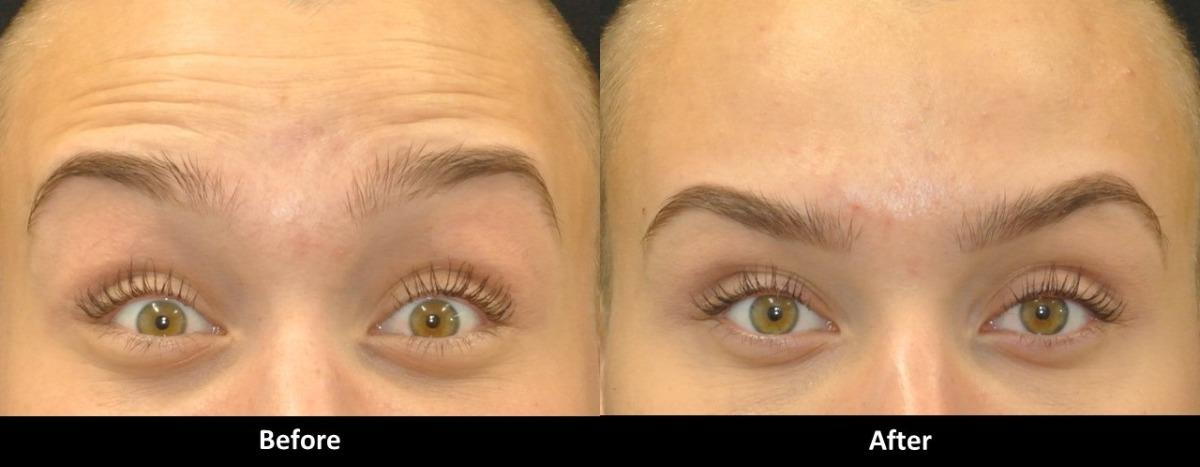
Did you know there’s an art to using Botox to treat wrinkles in the forehead? Keep reading to learn more.
What is Botox?
Botox is a purified protein used to treat wrinkles caused by facial expressions. The first wrinkles that were treated with Botox are the frown lines. These are usually vertical and you see them between your eyebrows when you frown. Sometimes they can be oblique, or at an angle, and some people can have a horizontal one across the bridge off their nose. Some people have one wrinkle, some have two, and some have more, everyone is different. It has to do with your specific anatomy and the way you make facial expressions. Horizontal forehead wrinkles can also be treated with Botox. As the name implies, these wrinkles so from one side of your forehead to the other. You either see these appear or see them get deeper when you raise your eyebrows. Another set of wrinkles that can be treated with Botox in the upper face are the crow’s feet. These are lines that look like crow’s feet and you see them appear or get deeper when you smile or squint.
How does Botox work?
Frown lines are seen when you frown a lot. You use your muscles so much that it creates an indentation in your skin that you see as a wrinkle. Boto works by relaxing your facial muscles. This way, when you frown, or make other expressions, your muscles won’t contract hard enough to make the wrinkle(s) visible.
What are the muscles in the forehead area?
You have three major muscle groups in your forehead area that can be treated with Botox. The highest muscle on your forehead is called the frontalis. It goes from the skin on your hairline to the skin under your eyebrows and its fibers are vertical. When you contract your frontalis, you raise your eyebrows. With repetitive contraction over time, this causes the horizontal forehead wrinkles you see either at rest and get deeper when you raise your eyebrows or appear when you raise your eyebrows. You have a complex of muscles in the area between your eyebrows called the glabella. When you frown, you contract your glabella muscles. This brings the inner parts of your eyebrows closer together and brings them down. As you frown over and over, you’ll see your frown lines appear and get deeper. You have another muscle in this area called the orbicularis oculi. This muscle goes around each eye like a circle. When you contract this muscle, it closes your eyes, like when you squint. You also use this muscle when you smile. This muscle pulls down the corners of your eyebrows. When you make these expressions many times over years, you can see crow’s feet around your eyes.
How does Botox treat these muscles?
As mentioned above, Botox works by relaxing muscles. So, to treat horizontal forehead wrinkles, you need to relax your frontalis muscle. This is the only muscle you have that can raise your eyebrows. So if it’s not treated perfectly, you may see some changes. For example, if it’s treated too aggressively or too low, your eyebrows may feel heavy and look lower than before. This is particularly true if you have a small forehead, if the Botox dose is too high, if the Botox is placed too low on your forehead, or if only your frontalis was treated without treating your frown lines and crow’s feet. At other times, if the entire muscle is not treated, one part of the muscle may still be active. This happens when the inner part of the frontalis is relaxed with Botox but not the outer part. What happens as a result is that you’re can lift only the outer part of your eyebrow and the brow looks peaked, giving a surprised look. It’s important to understand that all of these changes can be corrected. For example, if you have heavy eyebrows from only treating your frontalis, this is because the muscles that pull your brows down are still active. So you have an overall pulling down of your eyebrows. This is easily corrected by treating your glabella muscles and orbicularis oculi muscles with Botox. Doing this will relax the muscles you use to pull down your eyebrows, and this will lift your eyebrows back to their normal position. If you have a peaked eyebrow after treating your horizontal forehead wrinkles, this just means that a small part of the muscle wasn’t treated effectively. It doesn’t necessarily mean that it was done wrong; sometimes this just happens. This is even easier to correct. All you need is about two units of Botox above the peak.
How do you make sure your Botox results are perfect?
As discussed, there can frequently be small changes in the appearance of your forehead when treating your horizontal forehead wrinkles. Sometimes these are seen in a few days. But it takes a full two weeks to see your final results. Sometimes the Botox kicks in faster in some areas than others and the peaked or heavy eyebrows will correct themselves on their own. Therefore, it’s important to be patient and wait the full two weeks. At that time, you can return to the office to have your result perfected.
Dr. Alex has performed over 10,000 cosmetic treatments with many satisfied patients. Contact us to schedule an appointment for a free consultation with Dr. Alex in our Encino, CA office.

